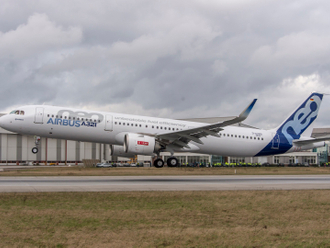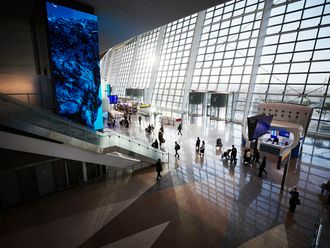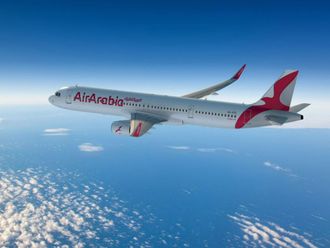African aviation, until recently dominated by airlines from former European colonial powers, is becoming a global free-for-all, helping to make the continent one of the world’s fastest-growing airline markets.
As aviation officials gather in Cape Town, South Africa, for the annual meeting of the International Air Transport Association, the rise of sub-Saharan Africa will be a central topic.
Big carriers from the Gulf are leading the charge. Qatar Airways, Dubai-based Emirates and Abu Dhabi’s Etihad Airways see the market as easy pickings in their backyard.
Meanwhile, US airlines that never served Africa are discovering the continent. And in a sign of Africa’s renewal, a growing number of carriers from the continent are expanding operations, although competing with global giants is proving tough.
The potential losers are European airlines, which until recently offered the only reliable connections to many African countries.
“The Europeans have suddenly started to wake up,” Emirates President Tim Clark says. While European carriers slowed their African expansion in recent years, “we saw it as a huge opportunity.” Emirates is closing in on Air France as the non-African carrier with the most traffic to Africa, according to consulting firm Innovata LLC.
Air France-KLM SA “continues to increase flights, routes and aircraft size in Africa to feed its European hubs,” says Pierre Descazeaux, the company’s senior vice-president for Africa and the Middle East. The group, which owns 26 per cent of Kenya Airways Ltd and 20 per cent of Air Cote d’Ivoire, is increasing Africa capacity by more than 8 per cent this summer from last.
Airlines were alerted to Africa’s potential by the rise of Brazil, Russia, India and China, which account for a growing share of Africa’s international trade and themselves are among the world’s fastest-growing aviation markets.
Although African aviation still suffers from decades of neglect, its infrastructure and safety record are improving. Passenger traffic in the year ended April 30 rose 7.3 per cent from a year earlier, albeit from a low base, a growth rate second only to that of the Mideast, according to IATA. Meanwhile, African wealth is climbing. The Organisation for Economic Cooperation and Development predicts Africa’s overall economy will expand 4.8 per cent this year and 5.3 per cent next.
Not long ago, the modest Africa traffic consisted mostly of Western business people, a few Africans who could afford to fly and international aid workers. Now, seats hold rising numbers of African businesspeople and citizens with newfound personal wealth. Chinese construction firms, Australian mining giants and US oil companies also fill flights.
“Next to the BRIC countries, it is a main growth market, with fast-growing economies, wealth and foreign investments from China and other countries,” says Etihad Chief Executive James Hogan. The carrier recently expanded its presence in Africa and struck deals with South African Airways and Kenya Airways in which the carriers sell seats on each other’s flights.
Africa has become important for Middle Eastern carriers because of their location between the continent and Asia, which are developing commercial links. While few Africa-Asia routes generate enough traffic for direct flights, Persian Gulf carriers can funnel small numbers of people from many places through the airlines’ hubs. Dubai, Qatar and Abu Dhabi also are convenient gateways for Indians living or working in Africa.
US carriers also are increasing their presence. Delta Air Lines Inc (DAL), which began direct flights to Africa in 2006, is now the largest carrier between the US and Africa, with about 37 per cent of passenger capacity, according to Innovata. South African Airways, the largest African trans-Atlantic carrier, has only 27 per cent.
While travelers gain from the increased competition, the arrival of global airlines from affluent markets “puts the African operator at a disadvantage,” says Raphael Kuuchi, director of industry affairs at the African Airlines Association in Nairobi, Kenya.
African airlines accounted for just 35 per cent of traffic to and from the continent last year and their share of capacity on overseas routes has fallen 16 per centage points over the last decade, according to the association. Middle Eastern airlines more than doubled their capacity to Africa over the same period.
Still, some African carriers have met the challenge by investing in modern planes and adopting creative strategies.
Ethiopian Airlines and Kenya Airways placed early orders for Boeing Co’s new 787 Dreamliner and are working to increase service. Several African carriers are now focusing on travel within Africa “and to regions where the competition is less keen and the growth potential high,” such Asia and Latin America, Kuuchi says.
For most of the jet age, people travelling to or from much of Africa had to transfer through Europe. National carriers of former colonists reaped fat profits on African routes because competition was limited. Europe still has more than 60 per cent of overseas capacity to Africa, compared with 30 per cent for Middle Eastern carriers, according to Innovata.
But traffic with the Mideast is growing about 10 per cent annually and “shows no sign of a slowdown,” says Roeland van den Bergh, a senior analyst at the Centre for Aviation consulting firm in Sydney.
While European airlines continue to target Africa, they are constrained by the stress of European economic crises or by restrictions on how many flights they can operate to some African countries.
Germany’s Deutsche Lufthansa AG serves 35 African destinations with its own planes, through its subsidiaries Swiss International Air Lines and Brussels Airlines, and through cooperation with EgyptAir Holding Co, Ethiopian Airlines and South African Airways, which are its partners in the Star Alliance marketing group. Lufthansa Vice President Carsten Schaeffer says the airline plans capacity increases in Africa this year.











